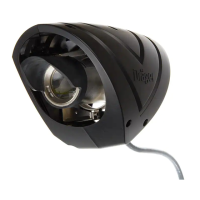Understanding The System
5
Understanding The System
Introduction
The Dräger Polytron Pulsar 2 detects hazardous releases of flammable hydrocarbons with the well established advantages of the open
path technique. To these it adds new and unique features which overcome common problems and annoyances in practical installations.
A Transmitter sends a beam of infrared light through the air to a Receiver. A release of hydrocarbon gases anywhere along the beam is
detected because they absorb particular infrared wavelengths selectively. Rain or snow in the air and dirt on the lenses do not cause a
false indication of gas because they do not share the same characteristic wavelengths. This proven 'open path' technique can achieve a
density of coverage and a speed of response that would otherwise require an extensive array of point detectors. The new features that
Dräger Polytron Pulsar 2 adds are these:
1 The light is produced by pulsed eye-safe sources with a peak power of 30kW. With this high Transmitter power, the Receiver is made
immune from sunlight and resonance effects associated with vibration from rotating machinery. Having more than one source ensures
that, in the unlikely event of a failure, the system remains functional until the Transmitter can be exchanged.
2 The performance of all open path instruments depends on the accurate aiming of the Transmitter and Receiver towards each other.
Often the necessary detection paths require elevated and inaccessible locations. This can make the alignment difficult to do at the time
of installation, and difficult to check subsequently when the supporting structures may have moved. Uniquely, Dräger Polytron Pulsar 2
has internal sensors to measure the orientation of the Transmitter with respect to the Receiver, and vice versa. Besides being shown
graphically on a handheld terminal to make installation simple, the directional measurements are available remotely during normal ope-
ration, allowing the alignment to be checked. This feature also generates a pre-warning of changes in alignment before they can affect
normal operation, and prevents a detector being commissioned before it is correctly aligned.
3 There is a communication path for digital signals from the Receiver to the Transmitter. The Receiver can command the Transmitter to
double its power (to 60kW) and to increase the flash rate from 1Hz to 4Hz, allowing an eight-fold increase in light flux when visibility
is reduced by bad weather or (most importantly) by the mist of condensate often present in real incidents. The higher flash rate is also
triggered by the first indication of gas, allowing a validated gas reading to be output in a reduced response time. The link also allows
the alignment display for both Transmitter and Receiver to be viewed at both locations, making it easy for one person to install or
maintain the system.
4 Open path instruments can suffer interference if a receiver 'sees' another transmitter mounted nearby or in line with the intended one.
Uniquely Dräger Polytron Pulsar 2 can be switched to separate frequencies analogous to radio channels. Each Receiver locks onto
its own Transmitter and ignores light from its neighbours.
5 The Receiver incorporates a data-logger with a non-volatile memory, readable locally or remotely. The data provides a valuable aid for
diagnosing practical problems and preventing unnecessary maintenance work. Internally the information is used to monitor slow trends
of signal strength and provide a pre-warning signal when the lenses will require cleaning, unaffected by temporary weather conditions.
In addition to these electronic enhancements, Dräger Polytron Pulsar 2 has a mechanical design that provides exceptional stability and
ease of adjustment. The head units containing the optical components are mounted in lockable gimbals that allow separate vertical and
horizontal adjustments with the other axis clamped. Each axis can be adjusted with a controlled degree of friction provided by PTFE rings
then locked solid without disturbing the setting. An ABS moulded cover provides mechanical protection and helps minimise the tempera-
ture rise of the internal electronics.

